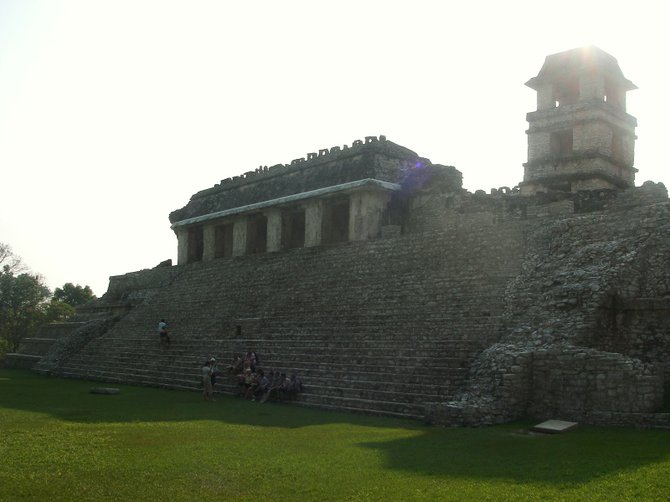 Facebook
Facebook
 X
X
 Instagram
Instagram
 TikTok
TikTok
 Youtube
Youtube

Amidst jungle-shrouded hills overlooking the Usumacinta River basin in the southern Mexican state of Chiapas, the Mayan site of Palenque is a jewel for anyone interested in ancient Mayan civilization.
Palenque offers a little bit of everything that an amateur Mayanist could want: impressive temples, tombs, ball courts and a grand palace. It also has some unexpected treasures that provide a glimpse into the daily life of its inhabitants.
An irrigation canal that flows alongside the palace provided the structure with running water for a sewage system and indoor toilets (the remains of which can still be seen). A huge steam bath complex and a natural system of waterfalls and pools known as the “Queen’s Bath” show the importance of hygiene to the ancient residents. Stucco relief sculpture and hieroglyphic tablets dot the site and tell the dynastic history of the city.
Palenque dates back over two millennia ago and was originally known as Lakam Ha, meaning “Big Water.” The city became prominent when Pacal the Great began his reign in 615 AD. He started an extensive building program that along with his subsequent rulers provided us with the famous structures we see today.
The Temple of the Inscriptions is home to Pacal’s tomb. Visitors used to be able to descend into the temple and see the famous sarcophagus that covered Pacal’s body, but it’s off-limits now. Nonetheless, there’s a tomb in a smaller temple nearby that held the body of the “Red Queen” – and, although not as elaborate, still represents an example of a royal burial.
There are many temples around the main core of the site and it pays off to climb the ones you can – not just for what you may find in and around them, but also for the views you’ll be rewarded with from atop them. I loved the whole site, but two areas really stood out to me:
The aforementioned “Queen’s Bath” is not only incredibly gorgeous, it also provides a shady reprieve from the heat and humidity you will experience in Palenque. You’ll utilize all your senses as you hear the rushing of the water, smell the aromas of the forest, feel the moisture in the air and see its beauty. It is a touch of Eden.
The other must-see area is the palace. It’s awe-inspiring walking through its corridors and seeing stucco images and painted designs still decorating the walls. There’s an open-air courtyard in the middle that contains tablets with images of captives to be vanquished or shown mercy, depending on the king’s whim. You can descend underground and see where the inhabitants slept. One of the most famous images of Palenque is its tower that some believe was used for astronomical purposes.
I’ve been to dozens of Mayan sites and still consider Palenque one of my favorites. It has something for the history buff, the nature lover and the explorer in all of us.


Amidst jungle-shrouded hills overlooking the Usumacinta River basin in the southern Mexican state of Chiapas, the Mayan site of Palenque is a jewel for anyone interested in ancient Mayan civilization.
Palenque offers a little bit of everything that an amateur Mayanist could want: impressive temples, tombs, ball courts and a grand palace. It also has some unexpected treasures that provide a glimpse into the daily life of its inhabitants.
An irrigation canal that flows alongside the palace provided the structure with running water for a sewage system and indoor toilets (the remains of which can still be seen). A huge steam bath complex and a natural system of waterfalls and pools known as the “Queen’s Bath” show the importance of hygiene to the ancient residents. Stucco relief sculpture and hieroglyphic tablets dot the site and tell the dynastic history of the city.
Palenque dates back over two millennia ago and was originally known as Lakam Ha, meaning “Big Water.” The city became prominent when Pacal the Great began his reign in 615 AD. He started an extensive building program that along with his subsequent rulers provided us with the famous structures we see today.
The Temple of the Inscriptions is home to Pacal’s tomb. Visitors used to be able to descend into the temple and see the famous sarcophagus that covered Pacal’s body, but it’s off-limits now. Nonetheless, there’s a tomb in a smaller temple nearby that held the body of the “Red Queen” – and, although not as elaborate, still represents an example of a royal burial.
There are many temples around the main core of the site and it pays off to climb the ones you can – not just for what you may find in and around them, but also for the views you’ll be rewarded with from atop them. I loved the whole site, but two areas really stood out to me:
The aforementioned “Queen’s Bath” is not only incredibly gorgeous, it also provides a shady reprieve from the heat and humidity you will experience in Palenque. You’ll utilize all your senses as you hear the rushing of the water, smell the aromas of the forest, feel the moisture in the air and see its beauty. It is a touch of Eden.
The other must-see area is the palace. It’s awe-inspiring walking through its corridors and seeing stucco images and painted designs still decorating the walls. There’s an open-air courtyard in the middle that contains tablets with images of captives to be vanquished or shown mercy, depending on the king’s whim. You can descend underground and see where the inhabitants slept. One of the most famous images of Palenque is its tower that some believe was used for astronomical purposes.
I’ve been to dozens of Mayan sites and still consider Palenque one of my favorites. It has something for the history buff, the nature lover and the explorer in all of us.
Comments